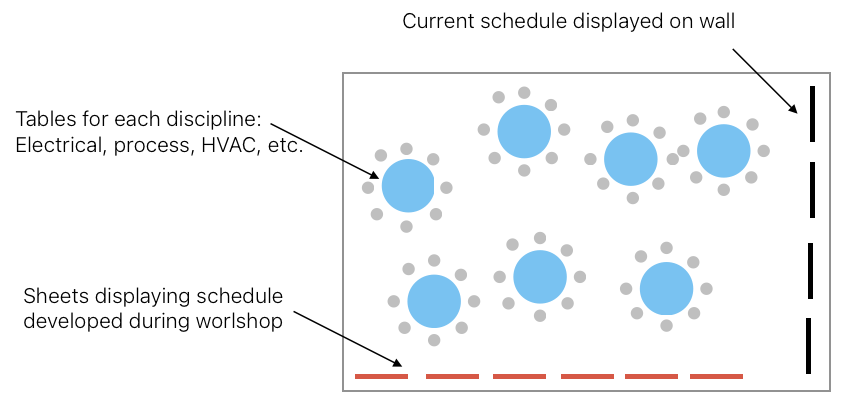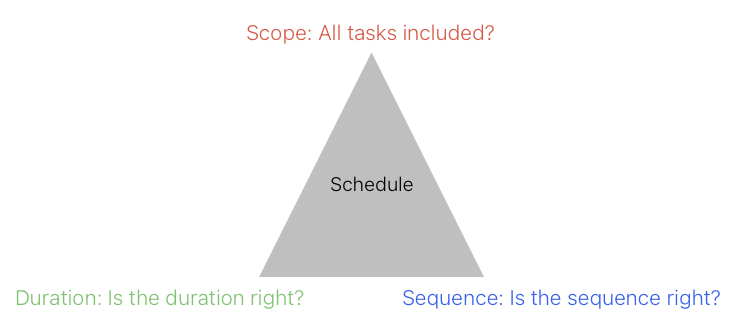Project Schedule: A Knife that Divides the Team or Glue that Unites?
It was yet another meeting in our $200 million fill-and-finish project. The agenda? To review the progress against the schedule.
Displaying the schedule on the screen, Gorky began describing the progress: area A is now 80% complete, the autoclave is on its way from Europe, the cooling towers will be delivered by the next week, and so on. As the main contractor’s Senior Planner, Gorky was known for outworking everyone: never left the project site before 8 pm. He was also one of the kind spirits who routinely mingled with workers to share meals.
After ten minutes of routine commentary, he disclosed the unsettling news: A few critical activities were delayed due to the late design changes, which would likely impact the target project completion date (31 Aug 20xx).

Listening to Gorky were twelve of us sitting around a long table: Four from the owner’s team [the Senior Project Manager (SPM) and the rest of us, including me (HVAC-SME)], the main contractor’s Project Manager (PM), Construction Manager (CM), other leads, and the qualification team. As expected, the discussion immediately turned to the dreaded d-word–delay–and what could be done to avoid missing the target completion date.
The goal post shifts
Suddenly, the door opened, and an unexpected participant joined the meeting. Gesturing to continue the discussion, she chose not to sit.
After 5-7 minutes, she opened her mouth, saying: “Guys, this is crazy! Forget the delay, we can’t even afford to drag this project down to Aug. Please listen carefully: This site should be ready by May end, i.e., commissioned and qualified, or we will lose millions of dollars of vaccine supply commitments. I repeat: May end!”
Commanding the undivided attention, she was Ms. Heck Lee (known as HL), the dynamic young Site Head, a person too senior to join these weekly meetings.
Just ten minutes back, the topic was why Aug. end date seemed unlikely—and now, it was why it couldn’t be done three months earlier.
It was a tricky situation. The current reality of the project and the goal Ms. HL was setting were far apart. If you accept her dictate, you’re doomed because it won’t happen. But if you disagree with her, you’re surely doomed!
For the first time, I could hear the sound of the aircon serving the room.
Then came the punch line from Ms. HL: “Work on this schedule, and I would like to see a revised schedule showing completion by May end in the next meeting. Thanks!” She left the room.
Sensing the panic in the room, our Senior Project Manager turned to “control the controllable” mode: He deputized Gorky, the Project Manager (PM), the Construction Manager (CM), and myself to “fix” the schedule.
We were quite a team: As mentioned earlier, Gorky was known for overcommitment to work. The PM was a green tea-drinking cool dude who had seen enough ups and downs to be perturbed by anything. CM was a hardcore construction man who blamed the project stress for his hourly smoking. And me? I was an HVAC guy with disproportionate outside interests in meditation and human psychology.
True to his style, Gorky wanted to straightaway plunge into the action, but the three of us reminded him that it was Friday evening.
Three forks in the road
On Monday morning, Gorky and the three of us sat down to discuss the “fix the schedule” mission.
Out of frustration, Gorky blurted out how he had never gotten enough time to work on the schedule properly—and how, under pressure, he was forced to paddle a half-baked schedule. No one, except him, had worked on the schedule—and now people were complaining about it.
The reality was indeed not pretty: Many people and contractors had no clue about the schedule—and were moving in different directions based on whatever targets were set for them in an ad hoc manner by different people.
But with our backs against the wall, we had a few critical decisions to make.
- First, should we squeeze everything to show the target completion as May end to please Ms. HL or fix the current schedule grounds-up, regardless of where we end up? It was Gorky himself who said: “To hell with HL’s arbitrary target date! I want to use this opportunity to prepare the best possible schedule. Let’s work grounds-up and see what emerges.” We all agreed.

- Second, we had another fork in the road: Should just four of us work on the schedule in isolation or make it an inclusive exercise by involving all the key stakeholders who would be affected by it? After a quick debate, we chose the second path: We would harness the knowledge and cooperation of key parties responsible for building the project.
- Third, we had yet another crucial decision: Should we approach each contractor/person separately for their inputs or organize a full-day workshop where all key players come together to discuss and help revise the schedule? We opted for a full-day workshop.
With our basic strategy in place, we had one major obstacle to cross. How to convince the Senior Project Manager (SPM) that instead of four of us fixing the schedule, we would involve everyone?
Losing the mind
Excited by our “progress,” when we shared our approach with the SPM, he lost his mind, blurting: “You guys have already wasted half a day to come up with this grand scheme. Just squeeze the damn schedule to suit HL’s target date—and we will see what happens later.” SPM was known for a daily dose of 8-10 cups of coffee to “manage stress” and never to mince his words.
Fortunately, we’re ready for this encounter with a plan. First, Gorky told him: “Probably, you’re right. Just squeeze everything to HL’s requirements. But the risk? Just a few months later, we will be missing critical milestones—and the same HL will be kicking our asses for not meeting the squeezed schedule. And as the leader, you will be facing the maximum heat.”
Sipping his coffee, SPM was now listening. After a 2-minute pause, I added: “You can ignore the reality, but you can’t ignore the consequences of ignoring the reality?” These wise words were not mine; it was a quotation attributed to Ayn Rand, the famous writer and philosopher.
Instead of arguing with him, we requested him to think about it over lunch.
After an hour, he reverted: “Go ahead, guys! Let’s do it!” We smiled! Our strategy of giving him space to think had worked.
Invitation declined
Our good mood phase, however, was short-lived. When the invites were sent to the key stakeholders, almost 30% declined, saying they couldn’t afford to sit in the conference room the whole day when there was so much pressure to meet the targets.
How to convince people?
We sweetened the deal: Reduced the workshop from full-day to half-day, shifted it to a nearby hotel, added lunch, and told people that evening dinner and drinks were on the house. We even came up with a clever title for the workshop: Game Changer!
It was indeed a game changer; all agreed to join the half-day workshop at the hotel.
Workshop day: Chaos & order
We were worried that so far, we had not done anything to the schedule but had invested all our energies into this crazy idea of a workshop. What if it were a total waste of time?
Getting into “whatever it takes” mode, four of us reached the hotel at 8:30 am and divided our preparation into two parts:
- Setup: We knew the setup of the ballroom could either aid or hinder the discussion. PM and CM stepped forward to own this piece.
- Structure: We also realized that unless we design a proper structure for the workshop, it could all end up in a mess. Gorky and I would own this piece.
Just as we were about to get into action, CM received a call, informing of a safety incident on the site. As he left the hotel, the three of us decided to forget the idea of 2-person teams; we would jointly set up and create a structure. The clock was ticking.
Setup
Our setup included three vital elements:
- Sitting arrangement: We asked the hotel staff to remove the long tables and replace them with 12 round tables with placards on each table: Automation, civil, electrical, HVAC, black utilities, process, qualification, etc. We wanted the people with similar responsibilities to sit together.
- Schedule on the wall: We printed the current schedule on multiple AO-size sheets and pasted them on the wall. People could walk around and read the schedule easily.
- Stationary: We provided each table with stacks of Post-it pads, felt pens, and blank AO-size sheets.

Structure of workshop
Once the setup was done, we crafted the following 5-step agenda to ensure we systematically extracted the right inputs from the participants:
- Step 1 (Shoot the schedule): All teams (electrical, civil, automation, etc.) should study the current schedule displayed on the wall. And more importantly, identify any flaws like missing activities, wrong sequencing, or impractical durations. We wanted to signal that the purpose of the workshop was to improve the current schedule–and not to somehow fit into it.
- Step 2 (Brainstorm and create): The next step involved different teams brainstorming among themselves to come up with a broad schedule for each service. They were to write the activities on Post-its and paste them on the sheets.
- Step 3 (Presentation): Next, every team needed to display their schedule on the wall and explain three things: key activities, sequences, and durations.
- Step 4 (Add it all): The next task was to bring all those individual schedules on multiple sheets to join together in a tentative overall sequence.
- Step 5 (adjustments): The final step was to make adjustments by moving the Post-Its to arrive at a more logical and seamless schedule.
Post-lunch, when people entered the ballroom, from the setup itself they sensed the significance of this event.
The workshop started well, but soon teams were clashing with each other: Everyone wanted to play safe and get more time for their activities without caring about others. At one point, it appeared we would end up with total chaos, but then Gorky came up with a bright idea: He announced a prize titled “Team with a Mission.” Based on participants’ voting, this prize would go to the most efficient and fair team, the team that showed maximum commitment to complete their activities as efficiently as possible without unduly squeezing others. That was a turning point.
Overall the workshop revealed that the current schedule needed to be fixed on all three fronts:
- Scope: Need to capture the complete scope of the project.
- Sequences: The linkages between some critical activities needed to be fixed.
- Duration: Some durations were either too optimistic or too pessimistic.
That night when we left the hotel, we were in high spirits, partly due to the drinks and partly due to the success of our workshop.

Difficult choice
The next day, we all sat around Gorky to help him incorporate all the inputs from the workshop and fix the current schedule on his computer. After six hours of back and forth, the revised schedule was ready, but there was one major problem: Now the project was ending not in Aug. end but in Oct. end. What to do about HL’s May end target?
Should we manipulate it to show a rosy picture or stay realistic? All four of us felt the Oct. end was the best possible outcome considering the constraints, and we should stay true to the truth.
We left the schedule aside and spent another hour discussing how to present it in a way that HL wouldn’t blow up her top.
Just as we were wrapping up our discussion, the news came that HL had invited her boss to the schedule meeting the next day. Her boss oversaw billions of dollars of projects worldwide and would be joining online from Europe. Wow! What was in store for us?
The D-day: Presenting the revised schedule
With everyone expectantly looking at Gorky, he began his presentation with neither the schedule nor the completion date. He stated the mission of our project: Patients First!
He thanked HL for joining the meeting the previous week, adding, “Because of you, we all woke up and worked on the project schedule like never before.” He went on to explain the elaborate process we had used to fix the schedule.
HL and her boss were listening intently.
Finally, Gorky came to three key points:
- The flaws in the original schedule: Missing activities, some wrong sequencing, and duration issues.
- Revised schedule and critical path: He displayed the revised schedule and explained the critical path.
- Final milestone: He boldly stated that the whole project would only end by Oct end. Strategically, he kept quiet about the original target (Aug. end), HL’s target (May end), or the d-word: delay.
He paused, waiting for HL to explode after hearing the bad news. Instead of saying anything, she left the room.
After an eerie silence lasting one full minute, she returned with a brown bag. And then her boss spoke:
“Gentleman, I have been in your shoes many times before and look at the project schedules every day. My experience is that most project teams start with a half-baked schedule, prepared by an isolated person, and commit important dates based on that unoptimized schedule. And for the rest of the project, they try to bend the reality to that unrealistic schedule and fight with each other. We don’t want that kind of planning and execution here.
Sometimes project teams need a shock. It was me who had asked HL to push you to the extreme.
From what I have heard, your schedule is reasonable, provided you stick to it.”
Smiling, HL took out a box of muffins from the brown bag and placed it in front of Gorky.
hvac-cq.com | Copyright © Atul Mathur 2023
